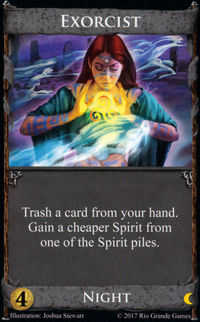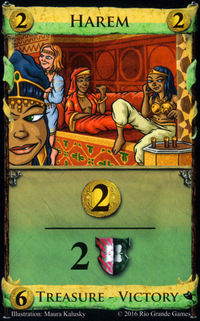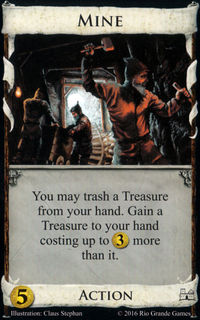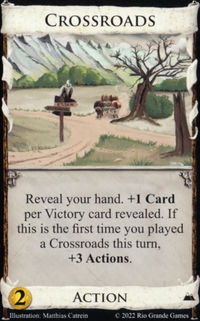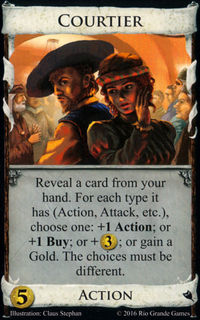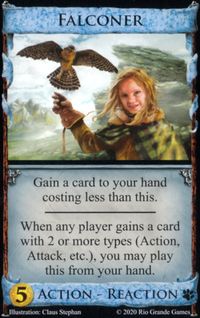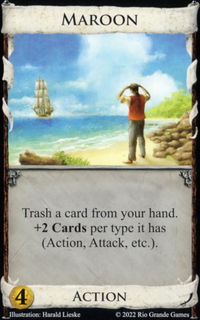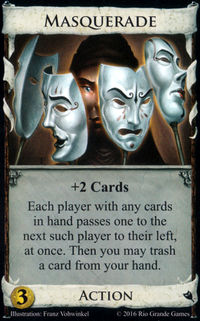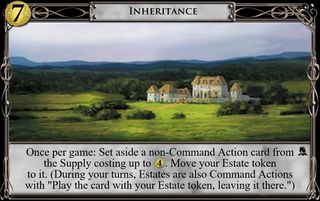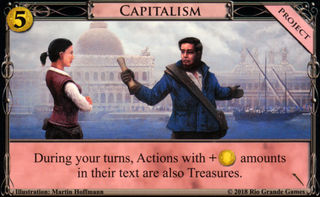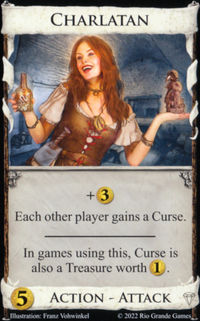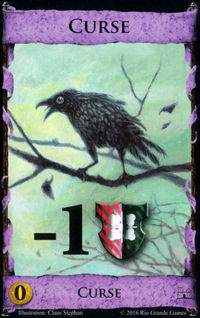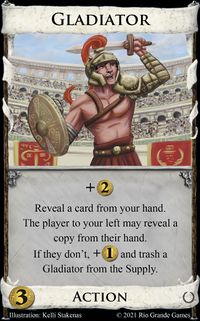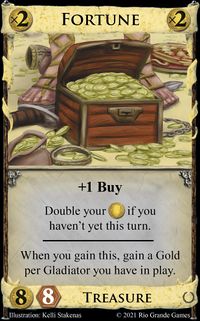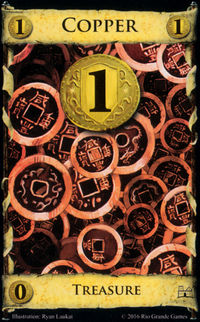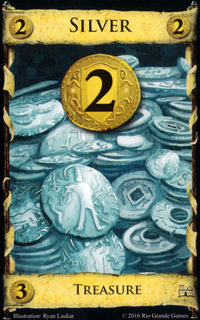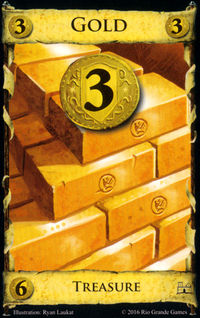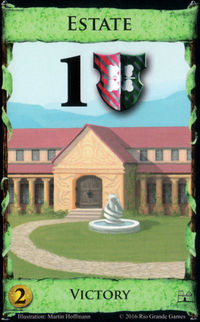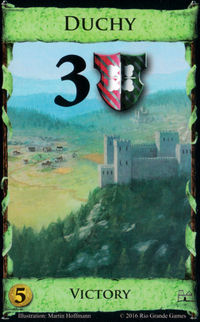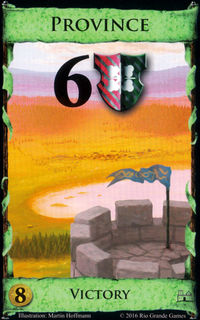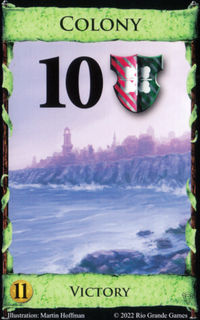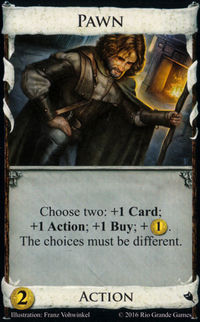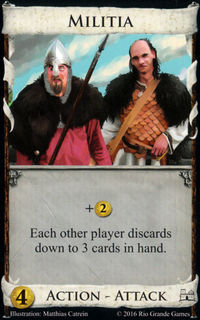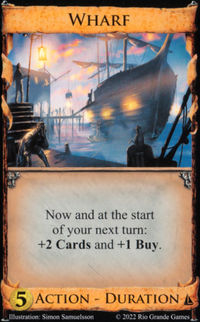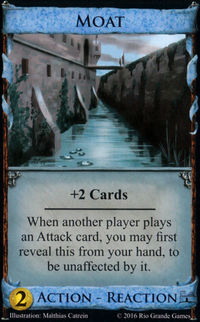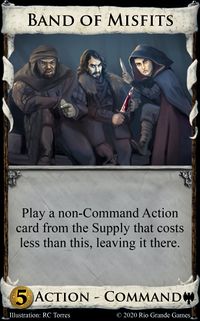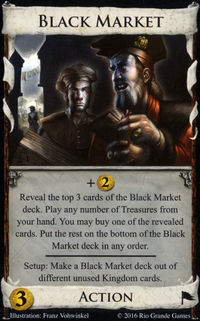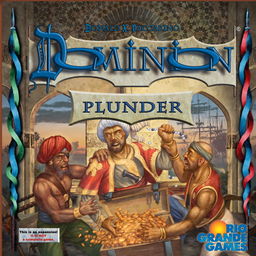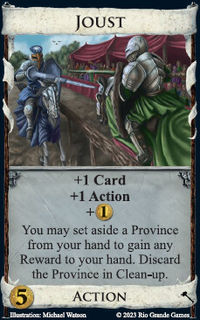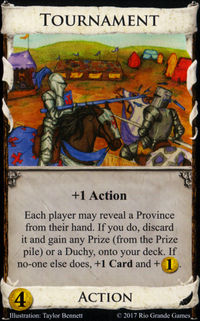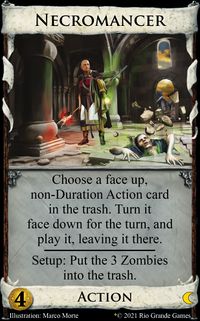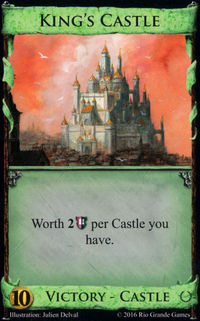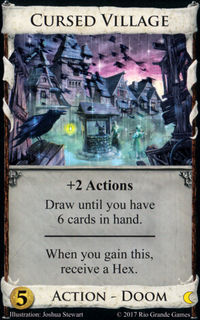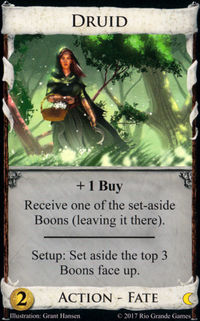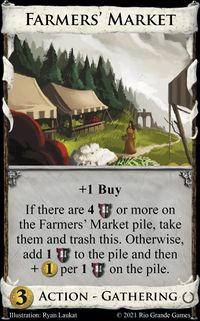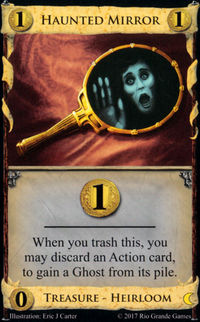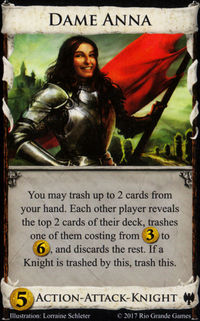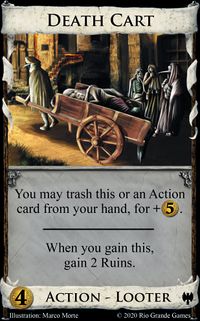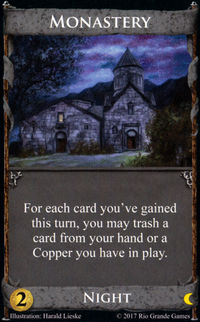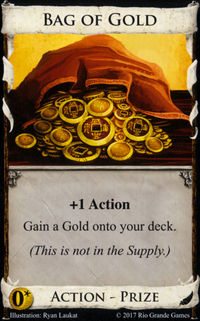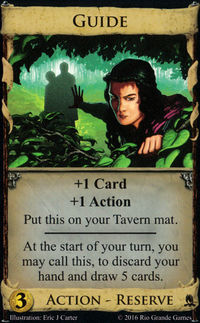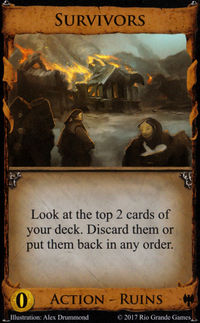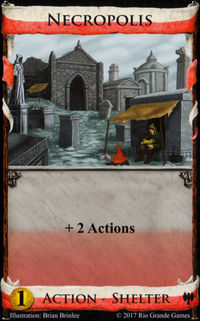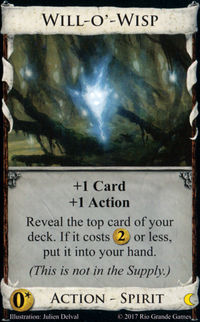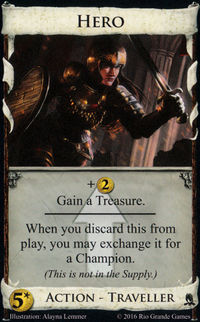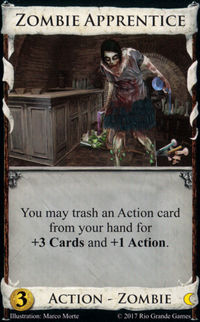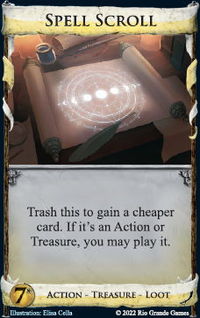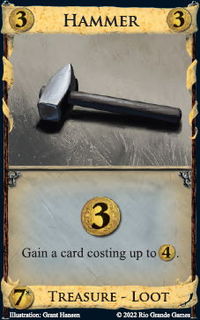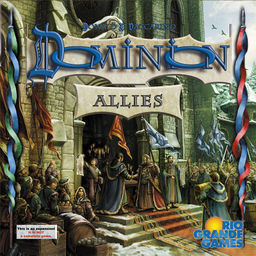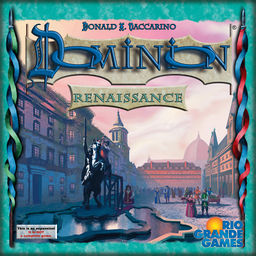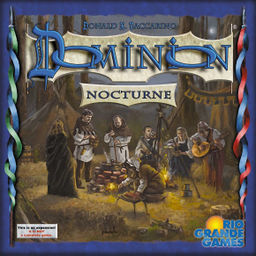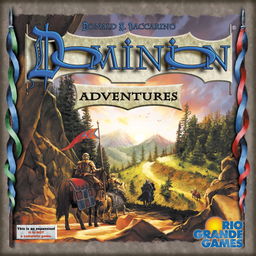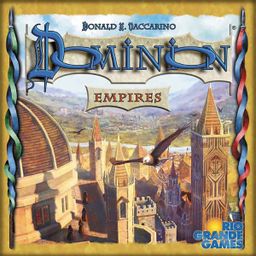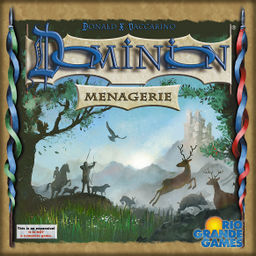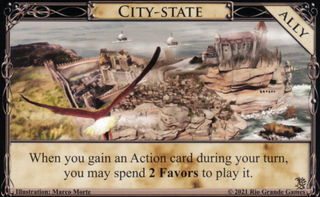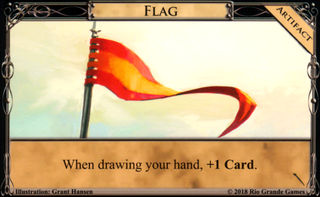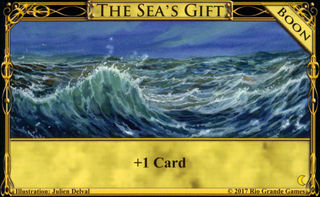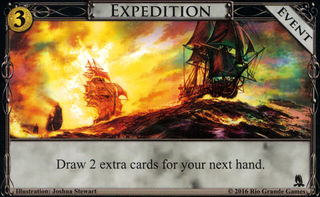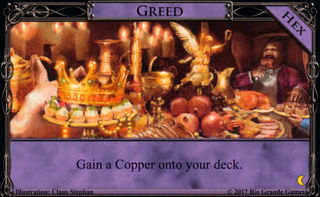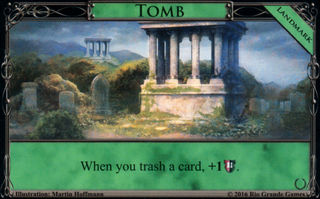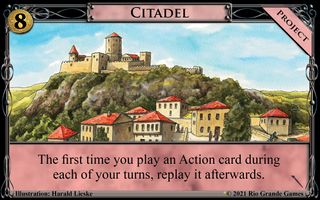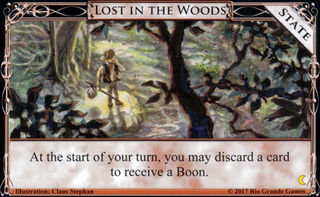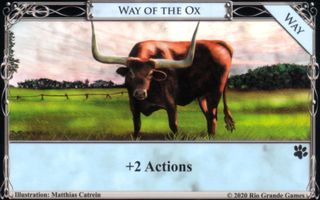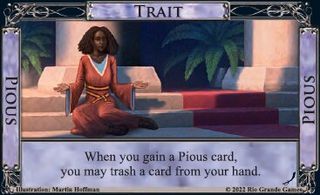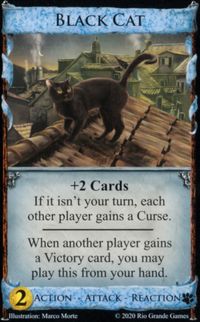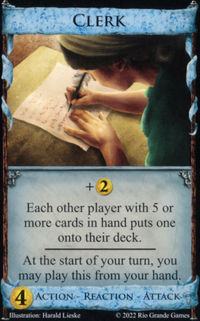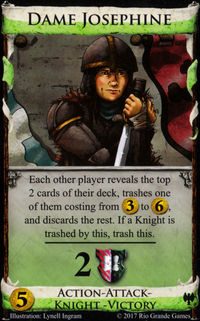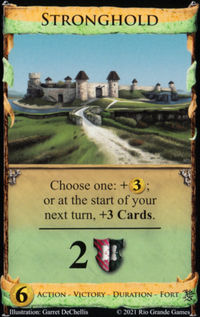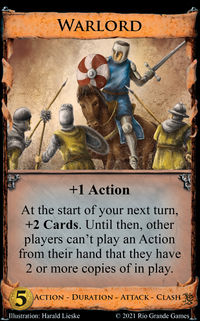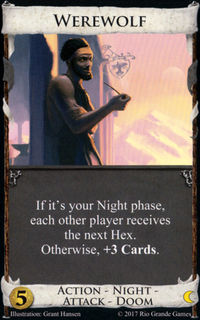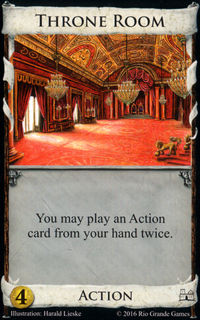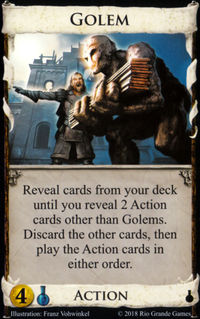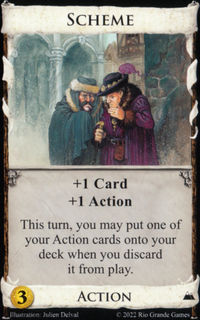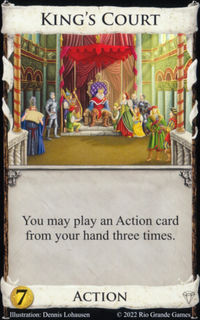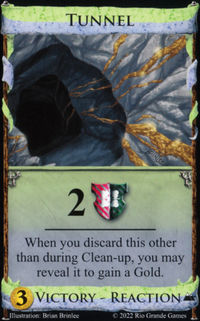Card types
Dominion cards are classified into several types, which determine how they can be used during gameplay and how they interact with other cards. Every card has at least one type, and all of a card's types are listed on the bottom banner of the card. The majority of cards have only one type, but many cards have two, some have three, and a few have four.
Some card types dictate how cards are used in terms of the basic rules of the game: for instance, the rules stipulate that cards of type Treasure may be freely played during the Buy phase of a player's turn, and cards of type Duration are subject to special rules that do not apply to other cards regarding when they are discarded from the play area. Other types have no special rules associated with them, and only exist so that other cards' abilities can refer to them collectively. For instance, cards of type Spirit share that type because the card Exorcist can be used to gain any of them, and the existence of the type allows Exorcist to be worded more compactly.
Cards with multiple types have membership in all of them for all purposes. For instance, Harem is a Treasure–Victory card; cards that have a special interaction with Treasure cards, such as Mine, and cards that have a special interaction with Victory cards, such as Crossroads, will both respond to Harem. Three cards, Courtier, Falconer, and Maroon, have abilities that are sensitive to how many types another card possesses.
A card is not a member of types that are not listed on the bottom banner of the card, even if they have abilities that resemble those of cards of that type. For instance, Masquerade can be used to put undesirable cards into an opponent's deck, or to remove desirable cards from it, but it is not an Attack card because it does not have "Attack" listed at the bottom of the card. However, there are a few abilities that can change cards' types for gameplay purposes: Inheritance causes Estates (normally just a Victory card) to also be Actions and Commands; Capitalism causes some Action cards to also be Treasures; and Charlatan causes Curses to also be Treasures.
Many card types are associated with a specific color; on cards of a given type, the background frame surrounding the card art and text are tinted in the appropriate color. Cards with certain combinations of types have two colors.
Occasionally some effects depend on the type of a pile in the Supply, rather than the type of a specific card. For split piles, which have multiple different cards in them which may belong to different types, the randomizer card for the pile indicates which types the pile as a whole is considered to have. For instance, Gladiator/Fortune is an Action pile, and therefore eligible to have Adventures tokens placed on it, even though Fortune is not an Action.
Contents |
[edit] The types
[edit] Basic types
Cards of these four types occur in all or almost all games of Dominion, and can appear as the only type on a card.
- Action. Action cards may be played during the Action phase of a player's turn. A player may play only one Action card unless some effect provides them with "+ Actions". Action cards may have a variety of different effects when played. The majority of Kingdom cards are Actions, but not all, so it is possible to play a game of Dominion with no Action cards (the probability of this happening by chance is on the order of 10–9). Action cards have white frames unless they are also Reactions, Durations, Ruins, or Reserves. Most Action card Kingdom piles contain 10 cards, though there are a few exceptions to this principle.
- Treasure. Treasure cards may be played during the Buy phase of a player's turn. A player may play any number of Treasure cards one at a time, in any order. There are a handful of Kingdom cards that can allow Treasures to be played during a player's Action phase. Most Treasure cards provide some amount of , and many have other effects when played. All games of Dominion include the basic Treasure cards: Copper, Silver, and Gold. Other basic Treasures are added under certain circumstances, and some Kingdom cards are Treasures as well. Treasure cards have yellow frames. Most Kingdom Treasure card piles contain 10 cards.
- Victory. Victory cards are usually worth
 at the end of the game to a player who has them. All games of Dominion include the basic Victory cards Estate, Duchy, and Province. An additional basic Victory card, Colony, may be included in games using Kingdom cards from Prosperity, and some Kingdom cards are Victory cards as well. Victory cards have green frames. All Victory card piles contain 8 cards in a 2-player game and 12 in a 3- or 4-player game.
at the end of the game to a player who has them. All games of Dominion include the basic Victory cards Estate, Duchy, and Province. An additional basic Victory card, Colony, may be included in games using Kingdom cards from Prosperity, and some Kingdom cards are Victory cards as well. Victory cards have green frames. All Victory card piles contain 8 cards in a 2-player game and 12 in a 3- or 4-player game.
- Curse. Curses are worth –1
 at the end of the game, and are the only card type to consist of only one card name. All games of Dominion include Curses in the supply, though in many games Curses will never be gained or otherwise interacted with. They have purple frames. The number of Curses in a game is equal to ten times the number of players after the first - 10 Curses for a 2-player game, 20 for a 3-player game, and so forth.
at the end of the game, and are the only card type to consist of only one card name. All games of Dominion include Curses in the supply, though in many games Curses will never be gained or otherwise interacted with. They have purple frames. The number of Curses in a game is equal to ten times the number of players after the first - 10 Curses for a 2-player game, 20 for a 3-player game, and so forth.
Examples:
[edit] Multi-expansion special types
Cards of these types appear in multiple Dominion expansions but never appear as the only type on a card.
- Attack. The "Attack" type has no special rules of its own, but several cards refer to the type and interact with Attack cards. For instance, several cards have special effects that are triggered when an Attack card is played. Attack cards usually inflict harmful effects on the opponents of the player who plays them, though not all cards that have the potential to harm opponents have the Attack type. Attack cards appear in all expansions, and are not associated with a color.
- Duration. Duration cards have effects that often last beyond the turn they are played; they are not discarded from play until the Clean-up phase of the last turn on which they do something. Duration cards were introduced in Seaside, and appear in later expansions beginning with Adventures. They have orange frames.
- Reaction. Reaction cards have effects that are triggered at unusual times or when the card is in a location not visible to all players (such as its owner's hand). When a Reaction card is triggered, on any turn including the owner's own turn, the owner may reveal it and carry out whatever abilities it has. Reaction cards appear in most expansions, and have blue frames.
- Command. Command cards are a small number of Action cards that can cause other Action cards to be played without moving them. They are not associated with a color. The type was introduced as part of the 2019 rules tweaks, and attached to a handful of cards that had been introduced earlier. It is used to stop these cards from playing each other in order to avoid infinite loops.
Examples:
[edit] Single-expansion special types
Cards of these types occur in only one Dominion expansion; except for Night, these do not appear as the only type on a card.
[edit] Types that affect gameplay rules or setup
- Doom. Doom cards have abilities that cause Hexes to be received. They appear in Nocturne and are not associated with a color.
- Fate. Fate cards have abilities that cause Boons to be received. They appear in Nocturne and are not associated with a color.
- Heirloom. Heirlooms are Treasures that replace players' starting Coppers. Each Heirloom has an associated Kingdom card with a yellow banner across the bottom; when one of these Kingdom cards is being used, all players replace one starting Copper with the indicated Heirloom. Heirlooms appear in Nocturne and are not associated with a color.
- Liaison. Liaison cards have abilities that grant Favor tokens. In a game in which Liaisons are being used, an Ally is selected to determine what effect Favor tokens have. Liaisons appear in Allies and are not associated with a color.
- Looter. Looter cards have effects that can cause Ruins to be gained; in a game in which one or more Looters are present (in the Supply or via a Black Market deck), Ruins are included in the Supply. All Looters are Action cards. Looters appear in Dark Ages and are not associated with a color.
- Night. Night cards are played during a player's Night phase, which is after the Buy phase. Night cards appear in Nocturne, and have black frames with white text.
- Reserve. Reserve cards are set aside on a player's Tavern mat when played, and can usually be called back into play to have an additional effect at a later time. Reserves appear in Adventures, and have tan frames.
- Ruins. Ruins are Action cards with very weak (but not harmful) effects that are included in the Supply in games using Looters. There are five differently-named Ruins, but they are shuffled into a single Supply pile. The Supply includes the same number of Ruins as Curses; players do not know which specific Ruins are in the Supply, in what proportions, or in what order. Ruins appear in Dark Ages and have brown frames.
- Shelter. Shelters may replace Estates in players' starting decks in games using Kingdom cards from Dark Ages. There are three differently-named Shelters, and each player starts with one of each. Shelters do not appear in the supply and may not be gained from anywhere; the only Shelters in the game are the ones players start with. Shelters appear in Dark Ages and have red frames.
[edit] Types that exist to label cards in a split pile
None of the following types have their own color.
- Augur. Augurs are pile of four differently-named Action cards in Allies.
- Castle. Castles are a pile of eight differently-named Victory cards with interrelated effects in Empires.
- Clash. Clash cards are a pile of four differently-named cards in Allies.
- Fort. Forts are a pile of four differently-named Action cards in Allies.
- Knight. Knights are a pile of ten differently-named Action–Attack cards with similar but distinct effects in Dark Ages . The Knights pile in the Supply is shuffled, so players do not know in what order the Knights will be available.
- Odyssey. Odyssey cards are a pile of four differently-named cards in Allies.
- Townsfolk. Townsfolk are a pile of four differently-named Action cards in Allies.
- Wizard. Wizards are a pile of four differently-named Action cards in Allies.
[edit] Miscellaneous
None of the following types have their own color.
- Gathering. Gathering cards collect
 tokens on their Supply piles, which can be taken after a certain condition is met. Gathering cards appear in Empires.
tokens on their Supply piles, which can be taken after a certain condition is met. Gathering cards appear in Empires.
- Loot. Loot cards are a pile of non-Supply Treasure cards costing that can be gained by a variety of effects. The pile of Loot cards is shuffled face-down, so players do not know the order in which the Loot will be gained. Loot cards appear in Plunder.
- Reward. Rewards are non-Supply cards that may be gained only as an effect of playing Joust. Rewards appear in the second edition of Cornucopia & Guilds.
- Prize. Prizes are the removed equivalent to Rewards from the first edition of Cornucopia, linked to the removed card Tournament.
- Spirit. Spirits are non-Supply cards that can be gained by Exorcist and a few other effects. They appear in Nocturne.
- Traveller. Travellers, when discarded from play, can be exchanged for stronger cards. Travellers appear in Adventures and, though they are not associated with a color, they are marked with a large arrow behind the card text.
- Zombie. Zombies are cards that start in the trash when Necromancer is being used. They appear in Nocturne.
[edit] Examples
[edit] Non-card types
These types are not "cards" in a gameplay sense, but are printed on physical cards; they are sometimes informally referred to as "card-shaped things". To distinguish them from cards, they are printed in landscape orientation. They are sometimes collectively referred to as "landscapes" for this reason.
- Ally. There are 23 different Allies that determine what the function of Favor tokens is in a given game. Liaison cards cause one Ally to be chosen at the start of the game. Allies appear in the Allies expansion and have beige frames.
- Artifact. There are 5 different Artifacts that have unique effects that players may contest ownership of. They appear in Renaissance and have brown frames.
- Boon. There are 12 different Boons that each mark a beneficial effect. Fate cards cause players to receive a random Boon. They appear in Nocturne and have golden frames.
- Event. There are 69 different Events that mark effects that players can pay for. They appear in Adventures, Empires, Menagerie, and Plunder and have silver frames.
- Hex. There are 12 different Hexes that each mark a harmful effect. Doom cards cause players to receive a random Hex. They appear in Nocturne and have dark purple frames.
- Landmark. There are 21 different Landmarks that mark effects that give players additional means to score (or lose)
 . They appear in Empires and have dark green frames.
. They appear in Empires and have dark green frames.
- Project. There are 20 different Projects that mark permanent effects that players can pay to activate, marking this with one of two wooden cubes. They appear in Renaissance and have pink frames.
- State. There are 5 different States that mark a persistent effect, although some States can be removed. They appear in Nocturne and have rust frames.
- Trait. There are 15 different Traits that attach extra abilities to a randomly selected pile in the Supply. They appear in Plunder and have a light purple broken frame.
- Way. There are 20 different Ways that have unique effects that players may choose to resolve instead of the main effect of the Action they are currently putting into play. They appear in Menagerie and have light blue frames.
Examples:
[edit] Trivia
In early drafts of Dominion, there was a type called "Token", which included Curse and Confusion. When Confusion was cut from the game, the type was renamed after its only remaining member, Curse.
The cards Black Cat and Clerk have the same combination of types, but Black Cat is labeled "Action-Attack-Reaction" and Clerk "Action-Reaction-Attack".
Early expansions rarely introduced new card types; later expansions have introduced multiple new card types in a single expansion. The numbers of card types introduced by each expansion are:
- Dominion: 6 (including the 4 basic card types) (Action, Attack, Curse, Reaction, Treasure, Victory)
- Intrigue: 0 (although Intrigue notably introduced cards with multiple basic card types)
- Seaside: 1 (Duration)
- Alchemy: 0
- Prosperity: 0
- Cornucopia: 1 (Prize)
- Hinterlands: 0
- Dark Ages: 5 (Command, Knight, Looter, Ruins, Shelter)
- Guilds: 0
- Adventures: 2 (+ 1 non-card type) (Reserve, Traveller) (Event)
- Empires: 2 (+ 1 non-card type) (Castle, Gathering) (Landmark)
- Nocturne: 6 (+ 3 non-card types) (Doom, Fate, Heirloom, Night, Spirit, Zombie) (Boon, Hex, State)
- Renaissance 0 (+ 2 non-card types) (Artifact, Project)
- Menagerie 0 (+ 1 non-card type) (Way)
- Allies: 7 (+ 1 non-card type) (Liaison, Augur, Clash, Fort, Odyssey, Townsfolk, Wizard) (Ally)
- Plunder: 1 (+ 1 non-card type) (Loots) (Trait)
Some statistics (as of November 2018):
- There are 22 different card types and 49 different combinations of card types, including 32 combinations for Kingdom card pile types.
- There are 8 non-card types.
- 239 cards have one type, 134 cards have two types, 30 cards have three types, and 4 cards have four types (Dame Josephine, Stronghold, Warlord, and Werewolf).
- The most common type is Action; the least common type is Curse (see table below).
- The only types to appear in multiple sets are Action, Attack, Command, Duration, Reaction, Treasure, and Victory. The only types to appear in every set are Action, Attack, and Treasure (including the basic Treasures of the base Dominion set).
- Night is the only type other than the main four (Action, Treasure, Victory, Curse) that has appeared as the only type on a card.
| Type | Kingdom Card Piles | Differently-named Cards | Kingdom Card Piles (2E only) | Differently-named Cards (2E only) |
|---|---|---|---|---|
| 334 | 405 | 322 | 393 | |
| Action | 286 (85.6%) | 326 (80.5%) | 274 (85.1%) | 314 (79.9%) |
| Attack | 51 (15.3%) | 64 (15.8%) | 48 (14.9%) | 61 (15.5%) |
| Treasure | 27 (8.1%) | 45 (11.1%) | 27 (8.4%) | 45 (11.5%) |
| Duration | 27 (8.1%) | 29 (7.2%) | 27 (8.4%) | 29 (7.4%) |
| Victory | 16 (4.8%) | 30 (7.4%) | 15 (4.7%) | 29 (7.4%) |
| Reaction | 13 (3.9%) | 14 (3.5%) | 12 (3.7%) | 13 (3.3%) |
| Night | 13 (3.9%) | 15 (3.7%) | 13 (4.0%) | 15 (3.8%) |
| Reserve | 8 (2.4%) | 9 (2.2%) | 8 (2.5%) | 9 (2.3%) |
| Fate | 8 (2.4%) | 8 (2.0%) | 8 (2.5%) | 8 (2.0%) |
| Doom | 6 (1.8%) | 6 (1.5%) | 6 (1.9%) | 6 (1.5%) |
| Looter | 3 (0.9%) | 3 (0.7%) | 3 (0.9%) | 3 (0.8%) |
| Gathering | 3 (0.9%) | 3 (0.7%) | 3 (0.9%) | 3 (0.8%) |
| Traveller | 2 (0.6%) | 8 (2.0%) | 2 (0.6%) | 8 (2.0%) |
| Castle | 1 (0.3%) | 8 (2.0%) | 1 (0.3%) | 8 (2.0%) |
| Knight | 1 (0.3%) | 10 (2.5%) | 1 (0.3%) | 10 (2.5%) |
| Heirloom | 7 (1.7%) | 7 (1.8%) | ||
| Prize | 5 (1.2%) | 5 (1.3%) | ||
| Ruins | 5 (1.2%) | 5 (1.3%) | ||
| Shelter | 3 (0.7%) | 3 (0.8%) | ||
| Spirit | 3 (0.7%) | 3 (0.8%) | ||
| Zombie | 3 (0.7%) | 3 (0.8%) | ||
| Curse | 1 (0.2%) | 1 (0.3%) |
[edit] Benefits of types
The ability of players to refer to the group is also nice. It's nice in the rulebooks too, even when there aren't special rules.
Of all existing types, conceivably I could have done without Gathering (living with those interactions). The others all feel like they're pulling their weight.[edit] Unused potential types
Donald X. Vaccarino at one point considered giving one-shots and Throne Room variants their own types, though he ended up not doing so:
It would have been simpler for Band of Misfits to play the card, rather than changing into the card. This was problematic with one-shots, duration cards, and throne rooms used on duration cards - and durations have a type to refer to (so it could conceivably say non-duration), but one-shots and thrones don't.
Scheme has an issue with the same set of cards. Scheme has this wonky wording that has you choose a card at the start of clean-up and then looks for you discarding that card from play - which tells us that it wasn't a one-shot or duration card that was sticking around or throne on a sticking-around duration card. There were a bunch of wordings of Scheme before I found that one. For example "When you discard this from play, you may put another Action card you have in play on top of your deck." Simpler, doesn't work with those three cases (incidentally doesn't let you Scheme the Scheme and doesn't double with Thrones, both of which went back and forth as I tried different wordings).
There are other issues. Doubling a doubler is often problematic in games (in this case, King's Court a King's Court). You can just not allow it with a type. I don't know if I would have (who doesn't like King's Courting a King's Court) but it wasn't an option. Duration cards require tracking when Throned, so there's a rule that Thrones stay out, which is kind of wonky, and in fact I reversed a ruling on King's Court / King's Court / duration. You could avoid the issue by saying non-duration on Throne, but I couldn't because Throne came first (and you could avoid it with non-throne on thrones). In the Seaside rulebook it refers to something like "actions that play/modify" actions, which confuses people. A type would clear that up.
Again this is all hypothetical; I don't know what the wordings would have been if I'd had more options (i.e. maybe they would be the same as they ended up), and in the end I did the cards I wanted anyway.[edit] How were the colors for each type chosen?
Durations originally had no special color. When I added that, I would have made it blue to tie in with Seaside but blue was taken. Orange was unused and vaguely suggests sand.
After that (Shelter, Ruins, Reserve) we are really just looking at, man what colors are left, pick one.[edit] The purpose of colors
Attacks meanwhile have a functional identity but don't need to call attention to themselves. At one point they had a different color, and possibly some players would prefer that. You can argue that you want to note that other players can interact with you with them, although then, why not non-Attack interaction too?
Shelters are a special case; they needed a color. They have a variety of other types and couldn't be pure the other color, because Actions do that for Reactions. You can also argue some ease of separation there, and for Ruins. It does maybe help a little in your hand to have Shelters and Ruins distinguished from (other) Actions.
